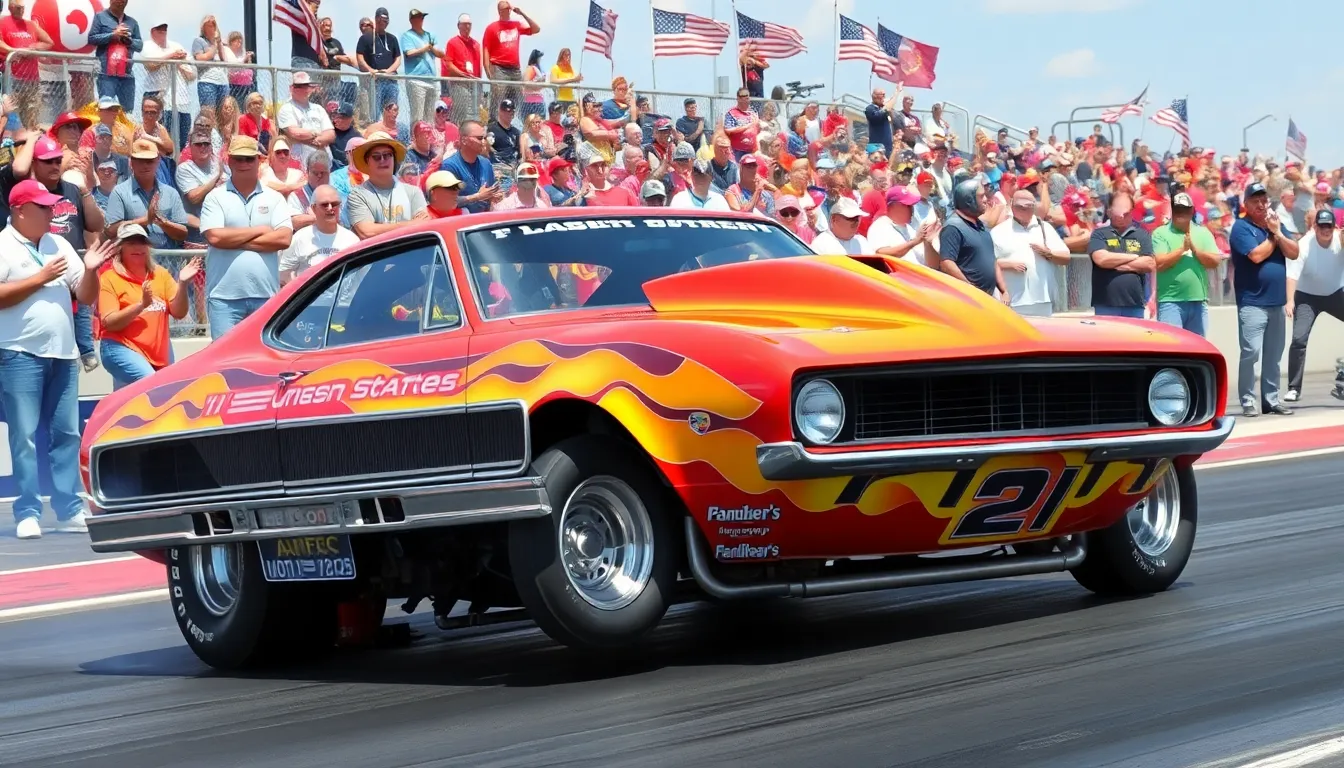When we hear the term “funny cars,” we’re not talking about clown vehicles or comedy props on wheels. We’re diving into the electrifying industry of drag racing’s most spectacular and powerful machines. These nitromethane-breathing beasts represent the pinnacle of quarter-mile performance with their distinctive tilting fiberglass bodies and earth-shaking 11,000+ horsepower engines.
What makes funny cars truly special isn’t just their incredible speed—it’s their unique combination of showmanship and raw power that’s captivated racing fans for decades. We’ve watched these mechanical marvels evolve from modified production cars in the 1960s to today’s purpose-built rockets that can accelerate from 0 to 330 mph in under four seconds.
Whether you’re a seasoned drag racing enthusiast or someone curious about automotive extremes we’re about to explore everything that makes funny cars the ultimate expression of speed engineering and entertainment rolled into one unforgettable package.
What Are Funny Cars and Why They’re Called “Funny”
Funny cars earned their distinctive name through their unconventional appearance and radical modifications that made them look anything but normal. We’ll explore how these drag racing legends got their memorable moniker and what design elements continue to make them stand out on the track.
The Origin of the Name
Spectators first coined the term “funny car” in the mid-1960s when they witnessed dramatically altered production vehicles that looked hilariously different from their street counterparts. Factory muscle cars like the Dodge Charger and Plymouth Barracuda underwent such extreme modifications that fans couldn’t help but chuckle at their transformed appearance.
Racing enthusiasts noticed how these vehicles maintained familiar body shapes while sporting wildly exaggerated proportions. The nickname stuck because drivers stretched wheelbases, raised rear ends, and installed massive racing slicks that gave these cars a comically distorted stance compared to showroom models.
Media outlets quickly adopted the term when reporting on match races featuring these modified machines. Popular racing magazines like Hot Rod and Drag Racing USA helped cement “funny car” in the drag racing vocabulary throughout the late 1960s.
Key Design Characteristics That Make Them “Funny”
Tilting body panels create the most distinctive visual element that separates funny cars from traditional dragsters. We see entire fiberglass bodies that flip forward like a clamshell, revealing the intricate chassis and engine components underneath during pit stops and maintenance.
Wheelbase extensions push the rear axle several feet behind the original factory position to improve weight distribution and traction. This modification creates an elongated silhouette that makes the car appear stretched and disproportionate compared to street versions.
Massive rear racing slicks measuring up to 33 inches tall dominate the visual profile while tiny front wheels create a dramatically raked stance. The extreme tire size differential gives funny cars their characteristic “nose high, tail low” appearance that immediately signals their racing purpose.
Shortened wheelbases in the front combined with extended rear sections create unusual proportions that challenge traditional automotive design principles. Racing teams deliberately engineer these awkward dimensions to optimize weight transfer during acceleration rather than aesthetic appeal.
Body modifications include relocated wheel wells, altered rooflines, and custom aerodynamic features that transform recognizable car models into purpose-built racing machines. These changes result in vehicles that retain just enough original character to be identifiable while looking completely transformed from their production origins.
The History and Evolution of Funny Cars
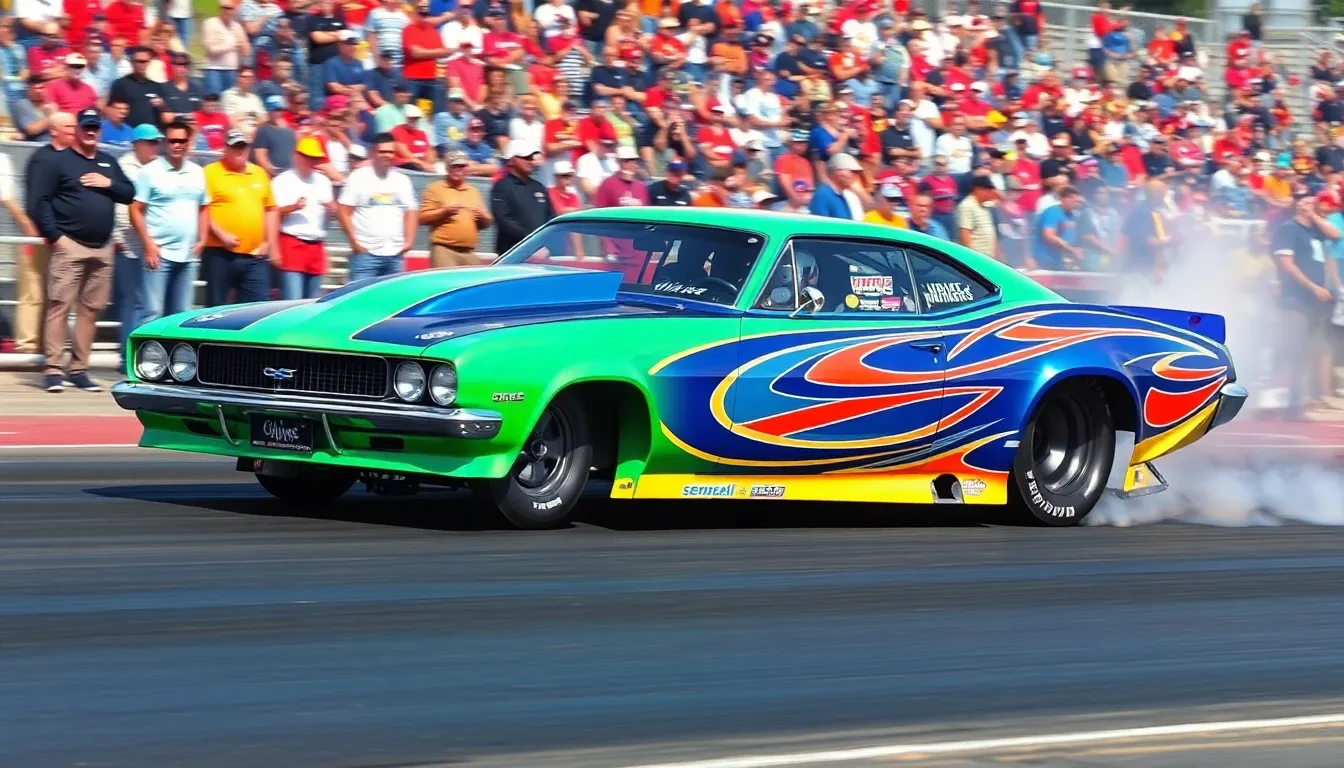
From humble beginnings to today’s technological marvels, funny cars have undergone dramatic transformations that reflect both racing innovation and fan entertainment demands.
Early Days in the 1960s
Experimental modifications began when racers started altering production vehicles beyond recognition in the mid-1960s. Teams discovered they could achieve better aerodynamics by moving the rear axle forward, creating the characteristic long nose and short rear deck proportions we associate with funny cars today.
Fiberglass body panels replaced heavy steel components as racers realized weight reduction was crucial for performance gains. Don “Big Daddy” Garlits and other pioneering drivers began lifting entire body shells off their chassis for easier engine access, establishing the tilting body design that became a funny car trademark.
Engine experimentation flourished as teams installed increasingly powerful motors that often exceeded 1,000 horsepower. Chrysler’s 426 Hemi and Ford’s 427 SOHC engines became popular choices, though their installation required extensive chassis modifications that further distorted the cars’ original appearance.
Safety concerns emerged quickly as these early funny cars proved difficult to control at high speeds. Roll cages became mandatory after several serious accidents, while fire suppression systems were added to protect drivers from fuel-related incidents.
Major Milestones in Funny Car Development
NHRA recognition arrived in 1969 when the National Hot Rod Association officially sanctioned funny cars as a professional drag racing class. This legitimacy brought standardized rules, safety requirements, and organized competition that helped the sport grow nationwide.
Nitromethane fuel became the standard in the early 1970s, allowing engines to produce over 3,000 horsepower and pushing elapsed times below six seconds. Teams learned to blend nitromethane with methanol in ratios up to 90%, creating explosive power that required specialized engine components.
Carbon fiber construction revolutionized funny car bodies in the 1980s, offering superior strength-to-weight ratios compared to fiberglass. Professional teams could now build lighter, more durable cars that could withstand the extreme forces generated by nitromethane-powered engines.
Computer technology integration began in the 1990s as teams started using data acquisition systems to monitor engine performance, tire pressure, and track conditions. Electronic fuel injection replaced mechanical systems, providing more precise fuel delivery and improved consistency between runs.
Modern Era Innovations
Advanced aerodynamics now govern funny car design, with computer-aided wind tunnel testing helping teams optimize body shapes for maximum downforce. Today’s cars generate over 5,000 pounds of downforce at 300 mph, requiring sophisticated suspension systems to handle these extreme loads.
Engine management systems control every aspect of modern funny car powerplants, from ignition timing to fuel delivery rates. Teams can adjust hundreds of parameters through laptop computers, fine-tuning their engines for exact track conditions and weather variables.
Safety technology has evolved dramatically with head and neck restraint systems, advanced fire suppression equipment, and impact-absorbing chassis designs. Modern funny cars feature multiple layers of protection that allow drivers to walk away from crashes that would have been fatal decades ago.
Digital timing systems now measure performance to thousandths of a second, while sophisticated data logging captures every aspect of a run for post-race analysis. Teams use this information to make precise adjustments between rounds, maximizing their competitive advantage in eliminations.
Top Funny Car Drivers Who Became Legends
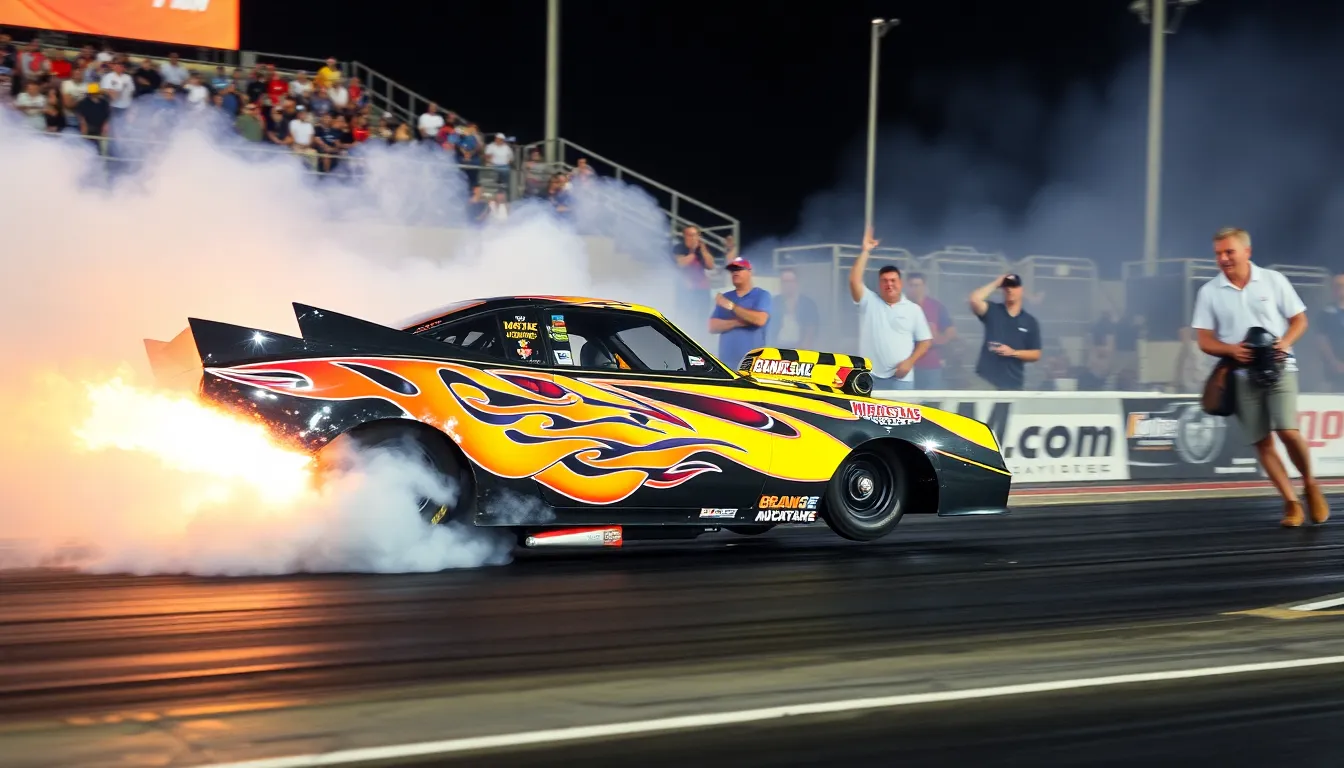
Behind every iconic funny car sits a driver whose skill and personality helped shape the sport we celebrate today. These racing legends transformed drag racing from a grassroots hobby into the professional spectacle that captivates millions of fans worldwide.
John Force and His Championship Legacy
John Force dominates funny car racing with an unprecedented 16 NHRA championship titles spanning from 1990 to 2013. His aggressive driving style and showmanship elevated the sport’s popularity throughout the 1990s and 2000s. Force’s career statistics include over 150 event victories, making him the most successful funny car driver in NHRA history.
Force Racing became a dynasty under his leadership, fielding multiple competitive teams simultaneously. His daughters Ashley, Brittany, and Courtney all followed his path into professional drag racing. The Force family operation revolutionized team management by treating funny car racing as both entertainment and serious competition.
Sponsorship relationships flourished under Force’s charismatic personality and marketing savvy. Major brands like Castrol GTX and Peak Antifreeze partnered with his teams for decades-long campaigns. His ability to connect with fans and media transformed funny car drivers from anonymous helmeted figures into recognizable celebrities.
Don Prudhomme’s Impact on the Sport
Don “The Snake” Prudhomme pioneered the professional funny car era during the 1970s with his innovative approach to racing. His famous rivalry with Tom “The Mongoose” McEwen generated massive fan interest and lucrative sponsorship deals with Hot Wheels toy company. Prudhomme’s three NHRA championships in 1975, 1978, and 1982 established him as funny car racing’s first major star.
Technical innovations marked Prudhomme’s racing career as he constantly pushed performance boundaries. His teams developed advanced clutch systems and aerodynamic improvements that other racers quickly adopted. The Snake’s methodical approach to setup and tuning helped establish funny car racing as a science rather than pure luck.
Media presence transformed through Prudhomme’s professional demeanor and articulate interviews. Television coverage expanded significantly during his championship years as broadcasters recognized his ability to explain complex racing concepts to casual viewers. His influence extended beyond racing into automotive culture through magazine features and product endorsements.
Modern Stars Carrying the Torch
Robert Hight continues the Force Racing legacy with four NHRA championships between 2009 and 2019. His consistent performance and technical expertise represent the evolution of funny car driving from pure aggression to calculated precision. Hight’s 60+ career victories demonstrate the sustained excellence required in modern professional drag racing.
Ron Capps achieved his breakthrough championship in 2016 after decades of near misses and runner-up finishes. His persistence through adversity inspired countless fans who appreciated his blue-collar work ethic and genuine personality. Capps’s victory celebrations became legendary for their emotional intensity and authentic joy.
Matt Hagan brings youth and innovation to funny car racing with three championships since 2011. His social media presence connects with younger demographics while maintaining respect for the sport’s traditions. Hagan’s driving style combines old-school bravery with modern data analysis techniques that maximize performance potential.
J.R. Todd represents diversity and fresh perspectives in funny car racing with his 2018 championship victory. His background in Top Fuel dragsters provided unique insights that translated into funny car success. Todd’s analytical approach to racing setup demonstrates how modern drivers must master both physical skills and technical knowledge to compete at championship levels.
Most Iconic Funny Cars That Changed the Game
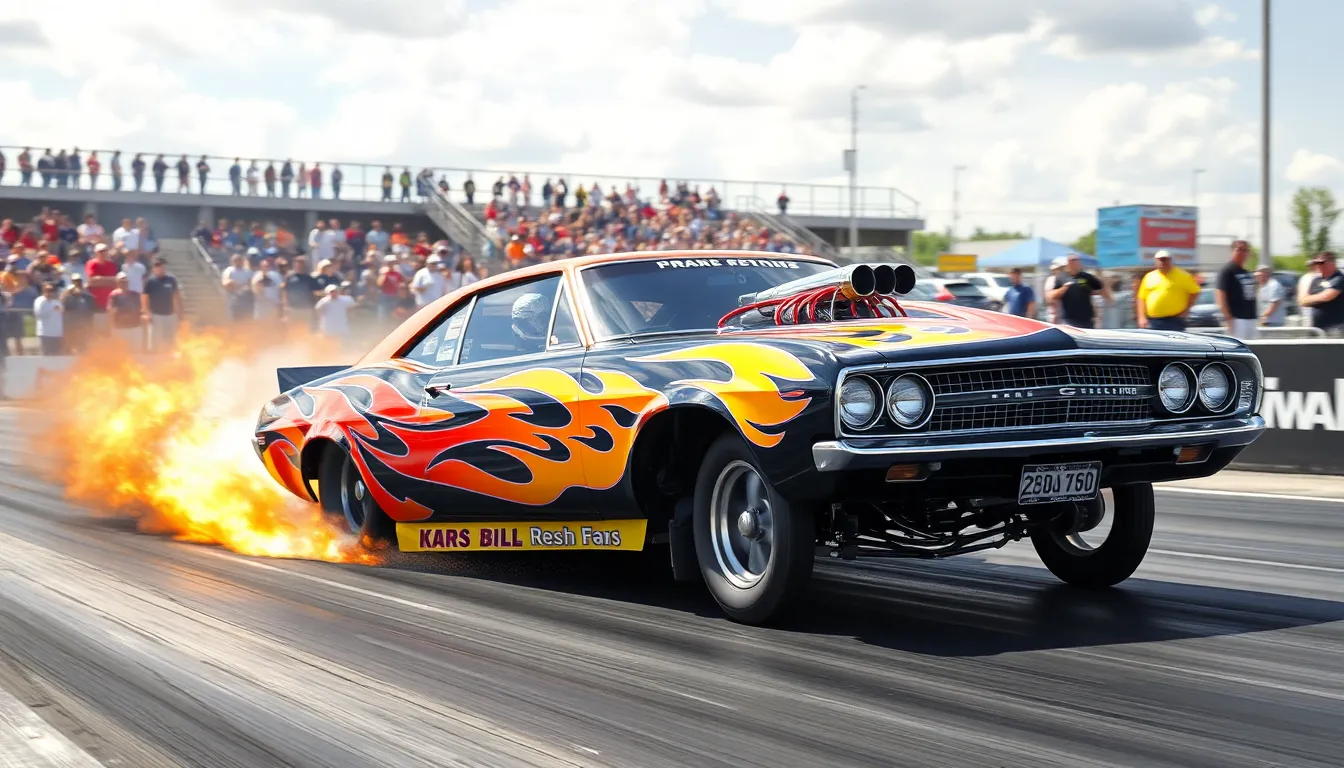
Certain funny cars have transcended racing history to become legendary machines that redefined what’s possible on the drag strip. We’ve selected the most influential vehicles that not only dominated competition but transformed the entire sport through their innovative engineering and unforgettable performances.
Classic Models from the Golden Era
“Jungle Jim” Liberman’s 1970 Chevrolet Camaro revolutionized the showmanship aspect of funny car racing with its wild paint schemes and Liberman’s theatrical antics. This iconic machine featured a lime green and yellow jungle theme that captivated audiences nationwide while consistently running sub 7-second quarter miles. Liberman’s Camaro became the template for combining entertainment value with serious racing performance.
Don Prudhomme’s “The Snake” Plymouth Barracuda established the professional funny car standard in the early 1970s through its methodical approach to racing excellence. The distinctive snake themed livery and Prudhomme’s precise driving style earned multiple championships while setting new benchmarks for consistency. This Barracuda proved that funny cars could be both spectacular and scientifically engineered for victory.
“Big Daddy” Don Garlits’ Dodge Charger transformed safety standards across the entire funny car category after Garlits suffered a major transmission explosion. His subsequent innovations in cockpit protection and fire suppression systems became mandatory safety requirements that saved countless lives. Garlits’ Charger demonstrated that technological advancement and driver safety could coexist with maximum performance.
Revolutionary Designs That Broke Records
Kenny Bernstein’s Budweiser King Top Fuel Funny Car became the first funny car to break the 300 mph barrier in 1992, reaching 301.70 mph at Gainesville Raceway. This achievement required revolutionary aerodynamic modifications and engine tuning that pushed the boundaries of nitromethane fuel systems. Bernstein’s breakthrough opened the door for modern funny cars to consistently exceed 330 mph.
John Force’s Castrol GTX Ford Mustang introduced computer controlled fuel injection systems that maximized power delivery while maintaining engine reliability. The sophisticated electronics package allowed Force to win four consecutive championships from 1993 to 1996 while setting multiple elapsed time records. This Mustang proved that technology integration was essential for sustained competitive success.
Cruz Pedregon’s Winston Camaro pioneered carbon fiber body construction that reduced vehicle weight by over 200 pounds compared to traditional fiberglass designs. The advanced materials allowed for more aggressive aerodynamic shapes while improving structural integrity during high speed runs. Pedregon’s innovation influenced every major funny car team to adopt lightweight composite construction.
Contemporary Funny Cars Setting New Standards
Robert Hight’s Auto Club Chevrolet Camaro SS represents the pinnacle of modern funny car engineering with its advanced data acquisition systems and real time telemetry monitoring. The sophisticated electronics package processes over 100 engine parameters per second to optimize performance throughout each run. Hight’s Camaro has won three NHRA championships while consistently running in the 3.80 second range at speeds exceeding 330 mph.
Matt Hagan’s Dodge Charger SRT Hellcat showcases cutting edge aerodynamic design with computational fluid dynamics optimized body panels and adjustable downforce elements. The aggressive styling incorporates functional air dams and spoilers that generate massive downforce while maintaining straight line stability. Hagan’s Hellcat has set multiple track records while proving that modern funny cars can be both visually stunning and mechanically superior.
Ron Capps’ Toyota GR Supra demonstrates advanced engine management technology with precise nitromethane delivery systems and cylinder by cylinder monitoring capabilities. The sophisticated fuel injection controls allow teams to extract maximum power while preventing catastrophic engine damage during competition. Capps’ Supra represents the future of funny car technology through its integration of automotive innovation and racing performance.
How Funny Cars Achieve Mind-Blowing Speed and Performance
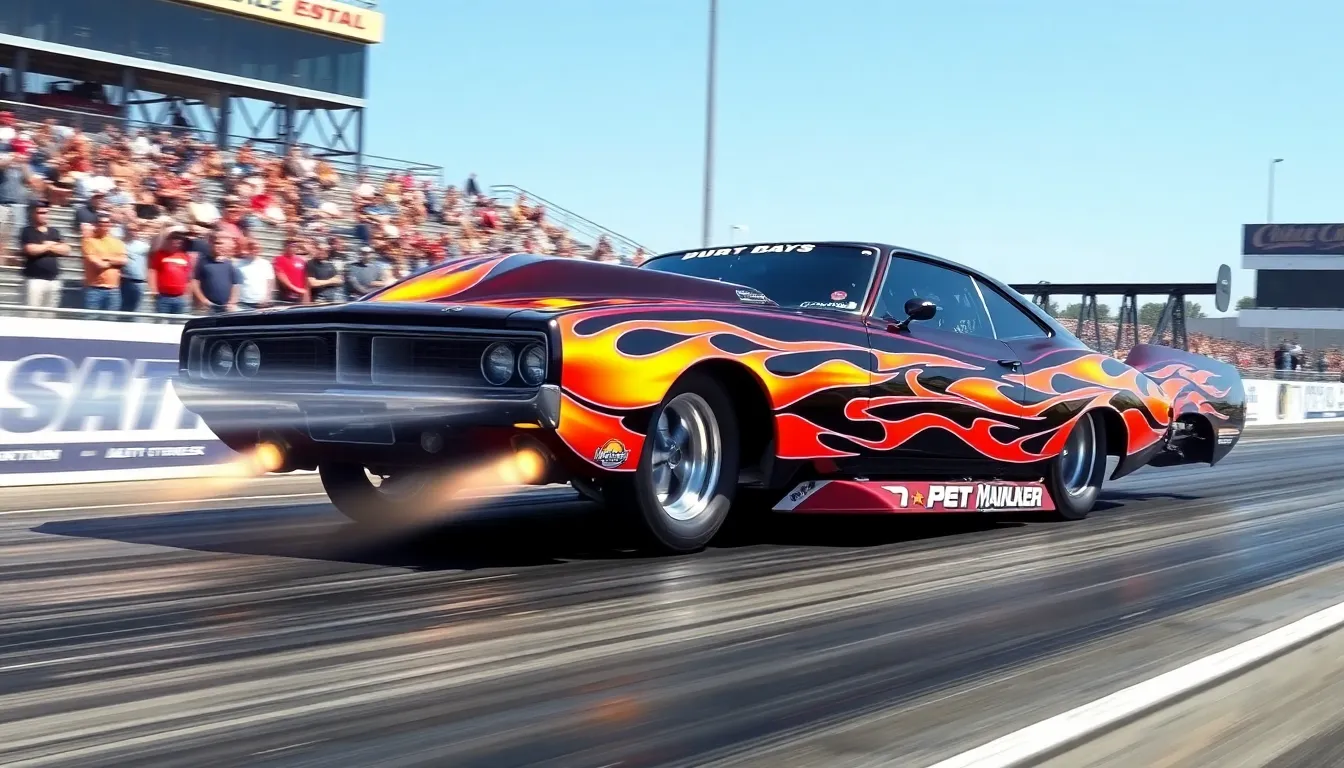
These racing machines represent the pinnacle of automotive engineering, combining raw power with cutting-edge technology to deliver breathtaking acceleration that defies physics.
Engine Specifications and Horsepower
Nitromethane-fueled engines power modern funny cars with devastating efficiency, producing over 11,000 horsepower from supercharged 500 cubic inch V8 powerplants. Racing teams use a fuel mixture containing 85-90% nitromethane, which burns at temperatures exceeding 3,000 degrees Fahrenheit and creates explosive power delivery.
Supercharger systems force massive amounts of air into combustion chambers through Roots-type blowers that spin at 7,000 RPM. These systems compress air to nearly 50 pounds per square inch, dramatically increasing oxygen density for more powerful combustion cycles.
Engine displacement remains limited to 500 cubic inches per NHRA regulations, forcing engineers to maximize efficiency through precision machining and advanced metallurgy. Teams rebuild these engines after every single run due to extreme operating conditions that would destroy conventional motors within seconds.
Compression ratios reach 6.5:1, which seems low compared to street cars but becomes optimal when combined with nitromethane’s unique burning characteristics. This setup allows engines to survive the incredible forces generated during four-second quarter-mile runs.
Fuel consumption reaches staggering levels as these engines burn approximately 15 gallons per quarter-mile pass, demonstrating the incredible energy required to accelerate 2,300 pounds to over 330 mph.
Aerodynamic Features and Body Design
Carbon fiber construction creates lightweight body panels that maintain structural integrity while reducing overall vehicle weight to enhance power-to-weight ratios. These advanced materials resist heat distortion and provide superior strength compared to traditional fiberglass alternatives.
Front spoiler systems generate downforce at the nose to prevent dangerous wheelstands that could flip vehicles during launch. Engineers design these components to create approximately 1,000 pounds of downforce at speed while maintaining optimal airflow to cooling systems.
Rear wing assemblies produce massive downforce through carefully calculated angles and surface areas that keep rear wheels planted during high-speed runs. These wings can generate up to 3,000 pounds of downforce at terminal velocity, essentially pressing cars into the track surface.
Body proportions follow exact dimensional requirements that create the characteristic “funny” appearance while optimizing aerodynamic efficiency. Extended wheelbases of 125 inches improve weight transfer during acceleration, while shortened rear overhangs reduce aerodynamic drag.
Air intake positioning channels fresh air directly to supercharger systems through strategically placed hood scoops that maximize airflow volume. These intakes must balance cooling requirements with aerodynamic efficiency to maintain optimal engine temperatures throughout each run.
Safety Innovations in Modern Funny Cars
Roll cage construction utilizes chrome-moly steel tubing in complex geometric patterns that protect drivers during catastrophic crashes or rollovers. These cages meet strict NHRA specifications requiring over 100 feet of precisely bent tubing welded to exact tolerances.
Fire suppression systems automatically deploy Halon gas throughout cockpit areas when sensors detect dangerous temperature spikes or impacts. Multiple redundant systems ensure driver protection even when primary safety equipment fails during emergency situations.
Ejection seat mechanisms allow drivers to escape quickly from damaged vehicles through explosive charges that blow off body panels and propel seats clear of danger zones. These systems activate within milliseconds of driver input or automatic crash detection.
Parachute deployment brings vehicles safely to a stop through dual parachute systems that deploy automatically at predetermined speeds or through manual driver activation. Backup parachutes provide redundancy when primary chutes fail or tangle during deployment.
Driver restraint harnesses secure pilots through six-point safety systems that distribute crash forces across multiple body contact points. These harnesses work with Hans devices to prevent basilar skull fractures during sudden deceleration events that generate forces exceeding 100 Gs.
Cockpit padding surrounds drivers with specialized foam that absorbs impact energy while maintaining comfort during normal racing operations. This padding meets strict flammability standards and resists degradation from nitromethane vapors and extreme heat exposure.
Major Funny Car Racing Events and Championships
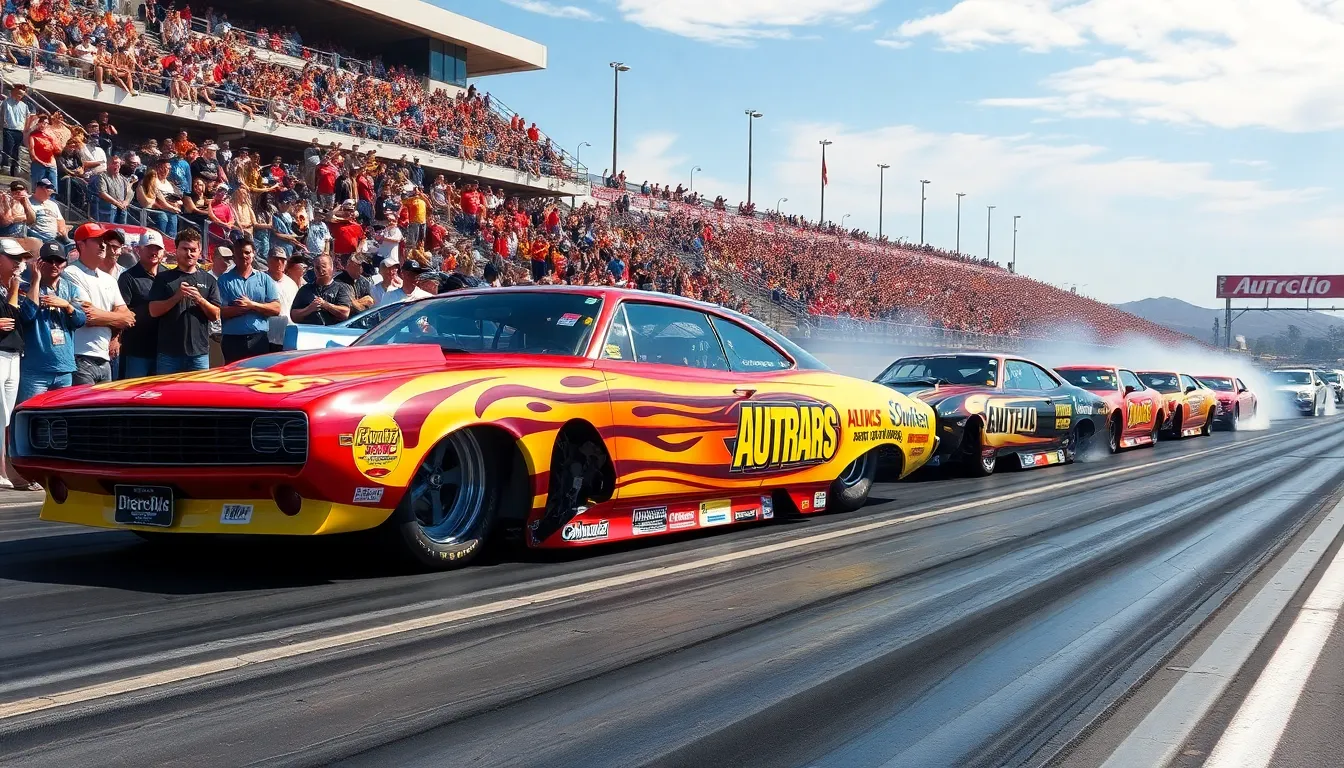
The funny car racing calendar features prestigious competitions that showcase these powerful machines to audiences worldwide. These events range from national championships to grassroots competitions that fuel the sport’s continued growth.
NHRA National Events
The NHRA Mello Yello Drag Racing Series represents the pinnacle of funny car competition with 24 national events held annually across the United States. We witness the most competitive racing at iconic venues like Auto Club Raceway at Pomona for the Winternationals and Indianapolis Raceway Park for the U.S. Nationals.
Points accumulation determines championship standings throughout the season, with drivers earning between 20 and 100 points based on their round-by-round performance at each event. The system rewards both qualifying performance and eliminations advancement, creating intense competition from the first qualifying session to the final round.
Television coverage brings these events to millions of viewers through FOX Sports broadcasts, featuring multiple camera angles that capture the drama of 330 mph passes in stunning detail. The production quality includes onboard cameras and slow-motion replays that showcase the incredible engineering behind these machines.
Prize money at national events can reach $50,000 for event winners, with additional bonuses for setting track records or achieving milestone performances. These purses attract the industry’s best drivers and teams to compete at the highest level of the sport.
Industry Championship Series
The NHRA Camping Industry Drag Racing Series crowns the annual funny car industry champion based on performance across all 24 national events during the racing season. We track championship battles that often extend to the final race of the year at Auto Club Raceway at Pomona.
International competition includes events in Canada through partnerships with organizations like the Canadian Hot Rod Association, expanding the reach of funny car racing beyond U.S. borders. These international venues provide unique challenges with different weather conditions and track surfaces.
The Countdown to the Championship format creates playoff excitement by resetting point totals for the top 10 drivers with six races remaining in the season. This system ensures that championship battles remain compelling through the final event, similar to other major professional sports.
Legacy champions like John Force have dominated this series with 16 titles, while current stars like Robert Hight and Matt Hagan continue to add their names to the championship roster. The championship trophy represents the ultimate achievement in professional funny car racing.
Regional and Local Competitions
NHRA Division races provide pathways for aspiring funny car drivers to compete at regional levels before advancing to national competition. These events feature the same safety standards and technical regulations as national events while offering more accessible entry fees and travel requirements.
Bracket racing programs at local tracks allow sportsman funny car drivers to compete on weekends throughout the racing season. We see these grassroots competitions featuring vintage funny cars and entry-level teams that preserve the sport’s heritage while developing new talent.
Match racing events bring professional funny car teams to local venues for exhibition runs and special competitions outside the national tour schedule. These appearances allow fans in smaller markets to experience the thunderous sound and spectacular performance of nitromethane-fueled engines.
Youth development programs through organizations like the NHRA Youth and Education Services introduce the next generation to funny car racing through educational initiatives and junior dragster competitions. These programs ensure the sport’s continued growth by captivating young enthusiasts in both driving and technical aspects of the sport.
The Technology Behind Today’s Funny Cars
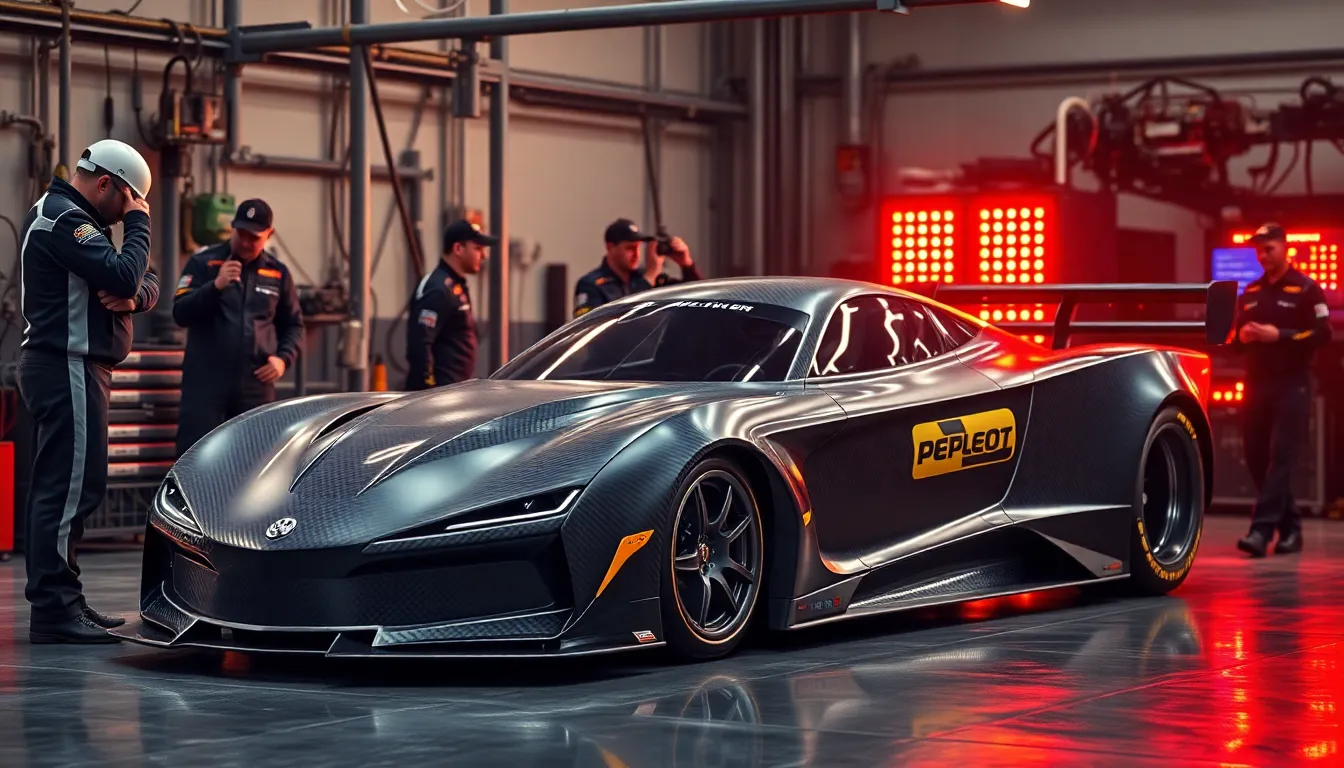
Modern funny cars represent the pinnacle of drag racing technology, where cutting-edge engineering meets raw power in a four-second spectacle that pushes the boundaries of physics.
Advanced Materials and Construction
Carbon fiber technology forms the backbone of contemporary funny car construction, replacing traditional fiberglass with materials that weigh 40% less while providing superior strength. Manufacturers like Strange Engineering produce chassis components using 4130 chromoly steel tubing that can withstand forces exceeding 8 Gs during acceleration. We’ve witnessed teams carry out titanium valves and connecting rods that survive extreme temperatures reaching 1,800°F in the combustion chamber.
Body panels now use advanced composite materials including Kevlar reinforcement layers that absorb impact energy while maintaining aerodynamic integrity. Racing teams employ computer-aided design software to optimize every curve and angle, creating bodies that generate over 2,000 pounds of downforce at speeds exceeding 300 mph. Weight distribution becomes critical with these materials, as teams can position the 2,300-pound minimum weight precisely where it benefits traction and handling.
Specialized aluminum components replace steel parts throughout the drivetrain, with manufacturers like Liberty’s Gears producing transmission cases that weigh just 85 pounds compared to 150 pounds for conventional steel units. Fire-resistant materials including Nomex fabric line the cockpit areas, while advanced foam padding systems protect drivers during potential impacts. Construction techniques now incorporate honeycomb core structures that provide maximum strength-to-weight ratios in critical safety areas.
Electronic Systems and Data Collection
Sophisticated data acquisition systems monitor over 200 parameters during each four-second run, capturing information from engine temperature to tire pressure at 1,000 samples per second. Teams use MSD Ignition systems with programmable timing curves that adjust spark delivery based on real-time engine conditions. We’ve seen racers carry out wireless telemetry that transmits critical data to pit crews before the car even crosses the finish line.
Engine management computers from companies like FuelTech control fuel injection timing with precision measured in thousandths of a second, optimizing power delivery throughout the acceleration curve. Digital dashboard displays provide drivers with essential information including engine RPM, oil pressure, and fuel flow rates during their runs. Advanced logging systems store data from practice sessions, qualifying rounds, and elimination runs to help teams fine-tune their setups.
Safety electronics include impact sensors that automatically trigger fire suppression systems and deploy parachutes in emergency situations. GPS tracking technology monitors vehicle speed and position with accuracy within inches, providing officials with precise timing and safety data. Modern funny cars feature backup electronic systems that ensure critical functions remain operational even if primary systems fail during competition.
Fuel Systems and Engine Management
Nitromethane fuel systems deliver precise amounts of the volatile fuel mixture through high-pressure injection systems capable of flowing 100 gallons per minute at peak demand. Racing teams use Waterman mechanical fuel pumps that generate pressures exceeding 500 PSI to ensure consistent fuel delivery throughout the acceleration curve. We’ve observed that modern fuel injection systems from companies like Hilborn Engineering can adjust flow rates 50 times per second based on engine load conditions.
Supercharger systems force-feed the fuel mixture into combustion chambers at pressures reaching 65 PSI, requiring specialized burst panels that protect engine components from catastrophic overpressure. Fuel management computers calculate optimal air-fuel ratios for different track conditions, with teams adjusting mixtures based on factors including air density, temperature, and humidity levels. Electronic fuel injection eliminates the guesswork of mechanical systems, allowing precise control over power output curves.
Specialized fuel additives including methanol percentages help teams fine-tune engine performance while preventing detonation at extreme compression ratios. High-flow fuel lines constructed from aircraft-grade materials withstand the corrosive nature of nitromethane while maintaining structural integrity under extreme pressures. Advanced fuel filtration systems remove contaminants that could damage precision injection components, with teams changing filters between each round of competition to ensure optimal performance.
Famous Funny Car Crashes and Safety Improvements
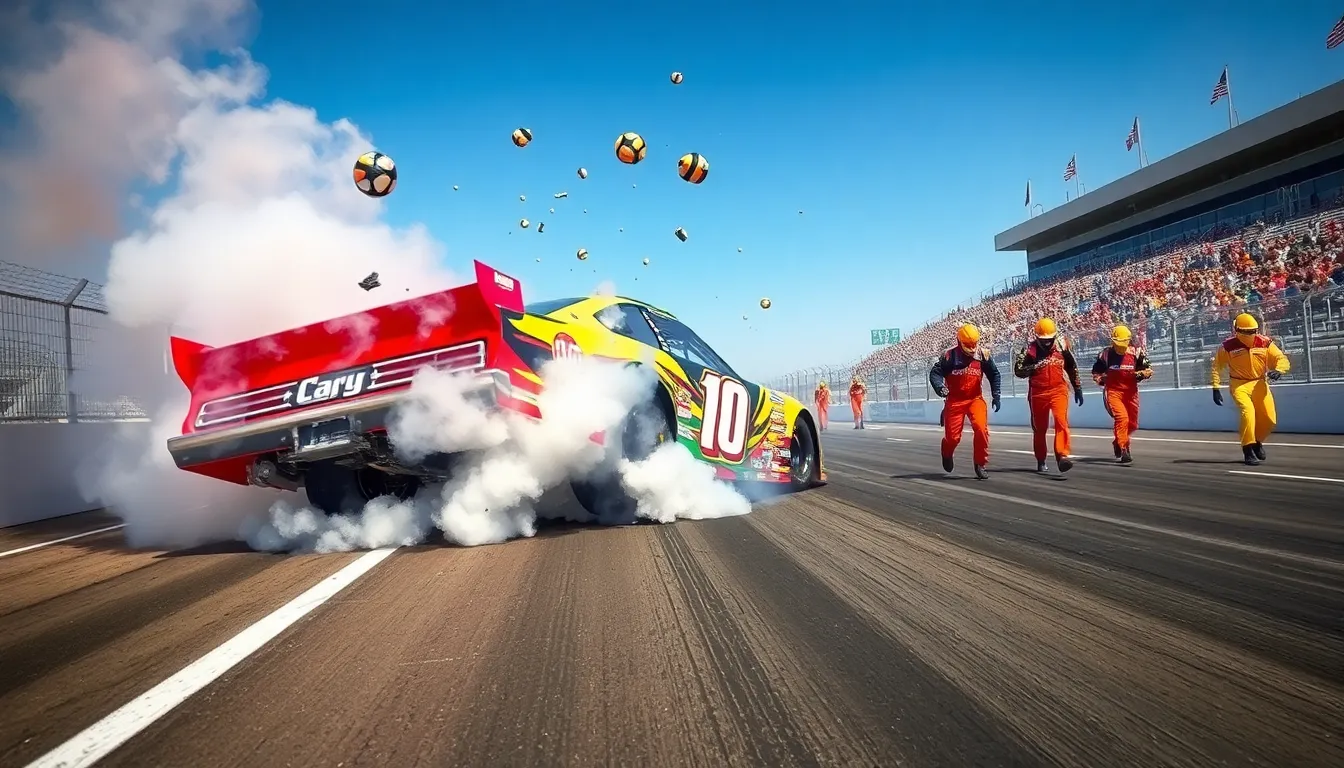
Funny car racing’s incredible speeds come with inherent risks that have shaped the sport’s evolution. Throughout drag racing history, serious accidents have driven revolutionary safety improvements that protect drivers and spectators alike.
Notable Incidents That Changed the Sport
Dale Pulde’s 1989 crash at Englishtown marked a watershed moment when his funny car hit the wall at over 250 mph, leading to immediate implementation of mandatory HANS devices. The National Hot Rod Association responded by requiring all drivers to install head and neck restraint systems within six months.
Tom McEwen’s 1982 fire incident during a Seattle qualifying run prompted widespread adoption of automatic fire suppression systems. His car’s fuel system ruptured during a burnout, creating a fireball that lasted over 30 seconds before safety crews could extinguish it.
Kenny Bernstein’s 1987 parachute failure at Phoenix International Raceway resulted in mandatory dual parachute systems for all funny cars exceeding 200 mph. His Budweiser King traveled nearly 1,000 feet past the finish line when the primary parachute deployed incorrectly.
Scotty Cannon’s 2007 explosion at Memphis Motorsports Park led to enhanced fuel cell regulations and improved cockpit ventilation systems. The methanol vapor buildup in his cockpit created an explosive mixture that injured him severely even though his safety equipment.
Ashley Force Hood’s 2009 crash at Bristol Dragway demonstrated the effectiveness of modern safety systems when she walked away uninjured from a 280 mph impact. Her accident led to improved side impact protection standards that became mandatory in 2010.
Safety Equipment Evolution
Roll cages transformed from basic steel tubes in the 1960s to sophisticated multi-point structures engineered with chromoly steel tubing that can withstand impacts exceeding 50 Gs. Modern cages feature 25 connection points compared to the original 8-point designs.
Fire suppression systems evolved from handheld extinguishers to automatic halon systems that deploy within milliseconds of detecting flames or excessive heat. Current systems include cockpit protection, engine bay coverage, and fuel cell suppression with multiple activation methods.
Driver restraint harnesses upgraded from basic lap belts to 7-point systems that distribute crash forces across the driver’s torso and pelvis. These harnesses work along with HANS devices to prevent basilar skull fractures during frontal impacts.
Ejection seats became standard equipment in 1995 after several incidents where drivers couldn’t escape burning cars quickly enough. These pneumatic systems can propel drivers clear of the vehicle within 2 seconds of activation.
Fuel cells replaced traditional gas tanks with military-grade bladders surrounded by impact-absorbing foam that prevents ruptures during crashes. Modern cells withstand puncture forces up to 500 pounds per square inch.
| Safety Component | Introduction Year | Current Standard |
|---|---|---|
| Roll Cage | 1968 | 25-point chromoly steel |
| Fire Suppression | 1975 | Automatic halon system |
| HANS Device | 1989 | Mandatory for all drivers |
| Ejection Seat | 1995 | Pneumatic activation |
| Fuel Cell | 1972 | Military-grade bladder |
Track Safety Measures
Concrete barriers replaced steel guardrails at most dragstrips after multiple incidents proved that energy-absorbing walls reduce impact forces by up to 60%. These SAFER barriers feature steel tubes backed by foam blocks that compress during crashes.
Sand traps and gravel runoff areas extended beyond traditional shutdown zones to provide additional stopping distance for cars experiencing brake or parachute failures. Modern tracks feature 1,500-foot runoff areas compared to 800 feet in earlier facilities.
Emergency response teams now include specialized medical personnel trained specifically in racing injuries and equipped with extraction tools designed for funny car cockpits. Response times have improved from 45 seconds in the 1980s to under 20 seconds today.
Track surface improvements include specialized traction compounds that provide consistent grip while allowing controlled tire spin during launches. These surfaces reduce the likelihood of cars veering into barriers during acceleration.
Spectator protection barriers received important upgrades following incidents where debris crossed into viewing areas. Modern facilities feature reinforced catch fencing that extends 50 feet higher than original installations and includes impact-resistant materials.
Building Your Own Funny Car: Costs and Considerations
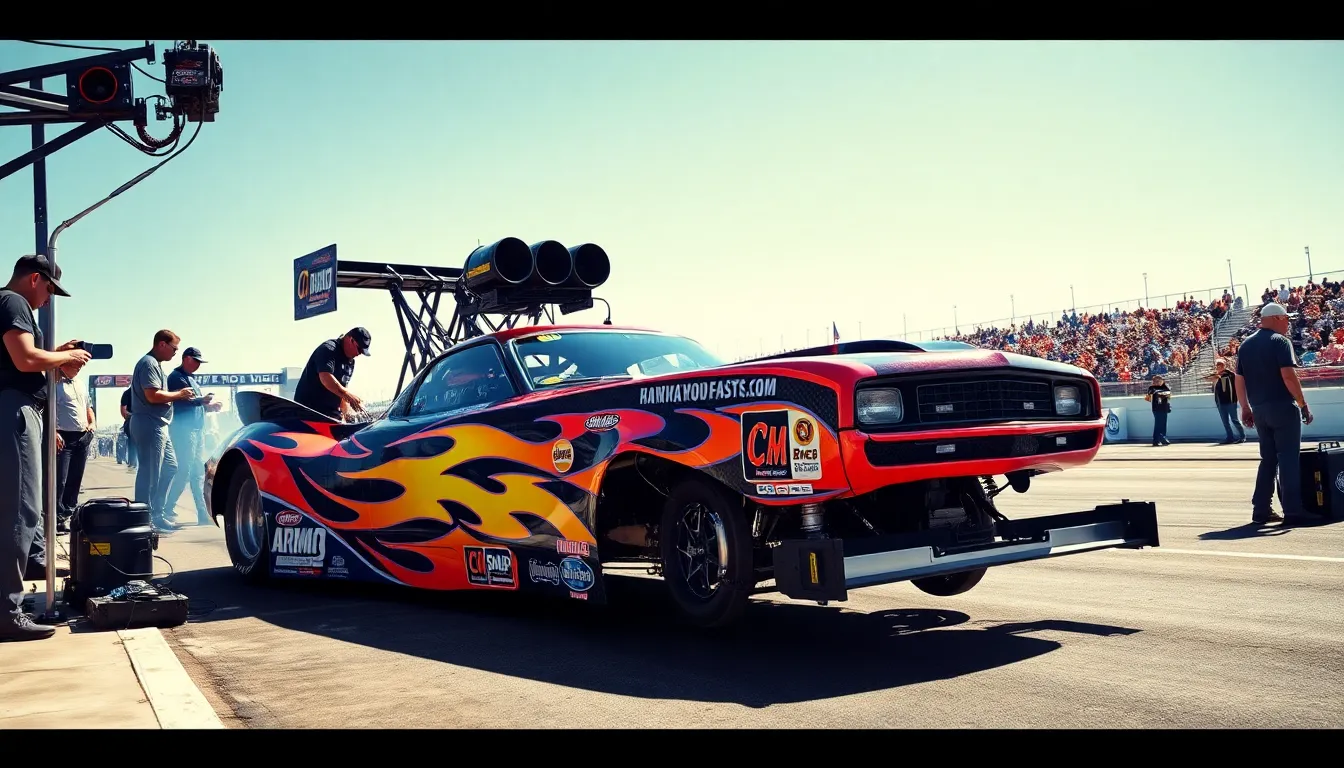
Building a competitive funny car represents one of the most expensive ventures in motorsports. We’ll break down the essential financial commitments and requirements you’ll face.
Initial Investment Requirements
Chassis construction forms the foundation of any serious funny car project, with professional-grade tube frame chassis costing between $75,000 and $125,000 from established manufacturers like McKinney Motorsports or Race Car Engineering. Custom fabrication adds another $25,000 to $40,000 for specialized mounting points and safety integration.
Engine packages demand the largest portion of your budget, as competitive nitromethane-burning powerplants range from $150,000 to $250,000 for complete assemblies. Supercharged alcohol engines offer a more affordable entry point at $75,000 to $100,000, though they’ll limit your competitive potential significantly.
Body panels and aerodynamic components typically cost $35,000 to $50,000 for complete carbon fiber shells, including front and rear wings. Fiberglass alternatives reduce costs to $15,000 to $25,000 but add weight that affects performance.
Safety equipment installation requires $40,000 to $60,000 for comprehensive protection systems. Roll cage construction, fire suppression systems, ejection seats, and HANS devices all meet NHRA specifications for professional competition.
Transmission and drivetrain components add another $25,000 to $35,000 to your build cost. Specialized clutch systems, reverse gears, and driveline components must withstand extreme torque loads that destroy conventional parts instantly.
| Component Category | Cost Range |
|---|---|
| Chassis Construction | $75,000 – $125,000 |
| Engine Package | $150,000 – $250,000 |
| Body and Aerodynamics | $35,000 – $50,000 |
| Safety Equipment | $40,000 – $60,000 |
| Drivetrain Components | $25,000 – $35,000 |
| Total Initial Investment | $325,000 – $520,000 |
Ongoing Maintenance and Operating Costs
Fuel consumption reaches staggering levels during racing operations, with nitromethane costing $30 to $40 per gallon and each run consuming 15 to 18 gallons. Practice sessions, qualifying runs, and elimination rounds quickly accumulate fuel costs of $3,000 to $5,000 per race weekend.
Engine rebuilds occur after every 6 to 8 runs due to extreme cylinder pressures and temperatures. Complete teardowns cost $15,000 to $25,000 per rebuild, including new pistons, rings, bearings, and valve components that survive just minutes of actual runtime.
Tire replacement happens frequently since racing slicks cost $800 to $1,200 per pair and typically last 8 to 12 runs before losing grip. Front runners cost $300 to $500 per pair and require replacement every 15 to 20 runs.
Clutch system maintenance demands attention after every racing session, with complete disc replacements costing $2,500 to $4,000 every 10 to 15 runs. Heat damage and explosive launches destroy clutch components faster than any other drivetrain element.
Transportation and crew expenses add substantial overhead to racing operations. Specialized haulers, crew salaries, hotel accommodations, and travel costs typically run $8,000 to $12,000 per race weekend for professional operations.
Parts inventory maintenance requires keeping spare engines, transmissions, and critical components on hand. Most competitive teams maintain $100,000 to $200,000 in backup parts to avoid missing races due to component failures.
| Operating Cost Category | Cost Per Season |
|---|---|
| Fuel and Chemicals | $25,000 – $35,000 |
| Engine Rebuilds | $60,000 – $100,000 |
| Tires and Wheels | $15,000 – $25,000 |
| Crew and Transportation | $80,000 – $120,000 |
| Parts and Maintenance | $40,000 – $60,000 |
| Annual Operating Costs | $220,000 – $340,000 |
Legal and Safety Requirements
NHRA licensing mandates completion of exact training programs and physical examinations before drivers can compete in funny car classes. Rookie drivers must complete NHRA’s Competition License program, which costs $500 to $800 and includes classroom instruction plus supervised track time.
Vehicle certification requires annual technical inspections that verify safety equipment meets current standards. SFI certification for roll cages, fire systems, and restraint harnesses must remain current, with recertification costs ranging from $2,000 to $4,000 annually.
Insurance coverage for funny car operations presents unique challenges since most standard policies exclude racing activities. Specialized motorsports insurance costs $8,000 to $15,000 annually for comprehensive coverage including liability, property damage, and medical expenses.
Track licensing varies by facility, with most requiring proof of driver certification and vehicle inspection before allowing practice sessions. Track fees range from $200 to $500 per day for testing, while race entry fees cost $800 to $1,500 per event.
Safety equipment updates follow evolving NHRA mandates that require periodic upgrades to fire systems, restraint devices, and structural components. Budget $5,000 to $8,000 annually for safety equipment updates and recertification processes.
Environmental compliance regulations govern fuel storage, waste disposal, and emissions in many jurisdictions. Proper hazardous waste handling, fuel containment systems, and environmental permits add $2,000 to $4,000 in annual compliance costs.
Future of Funny Cars in Drag Racing
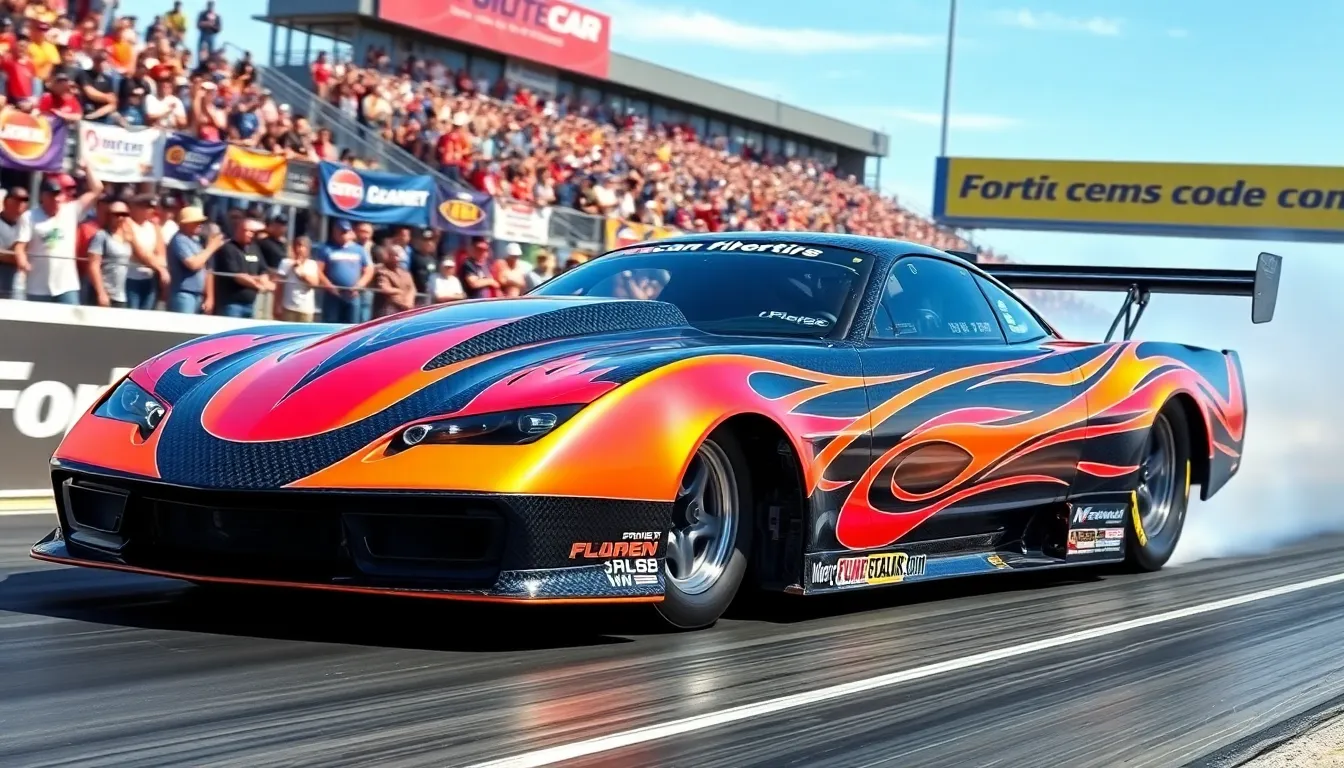
As funny car technology continues advancing at breakneck speed, we’re witnessing revolutionary changes that will reshape the sport’s industry. These developments promise to enhance performance while addressing modern environmental concerns and expanding global appeal.
Emerging Technologies and Innovations
Advanced materials are transforming funny car construction as manufacturers develop stronger carbon fiber composites that reduce weight by 15% compared to current designs. We’re seeing titanium alloy components replace traditional steel parts in critical areas like suspension mounting points and roll cage joints. Artificial intelligence systems now analyze telemetry data from over 300 sensors during each run to optimize fuel delivery and ignition timing automatically.
Hybrid power systems represent the next frontier in funny car technology, with prototype designs combining traditional nitromethane engines with electric motor assistance for enhanced launch performance. Computer controlled aerodynamic packages feature active body panels that adjust automatically based on track conditions and speed. Digital dashboard systems provide drivers with real time performance feedback through augmented reality displays integrated into their helmets.
3D printing technology enables teams to produce custom engine components and body panels within hours rather than weeks. Wireless data transmission allows crew chiefs to monitor engine parameters and make adjustments remotely during staging. Next generation fire suppression systems use advanced foam compounds that extinguish fires 40% faster than current halon based systems.
Environmental Considerations and Electric Options
Electric funny cars are becoming reality as battery technology advances to deliver the massive power output required for competitive performance. Tesla’s partnership with NHRA teams has produced prototype electric funny cars capable of achieving 280 mph speeds with zero emissions. Lithium ion battery packs weighing 800 pounds can now generate 8,000 horsepower for the brief duration needed in drag racing.
Synthetic fuel alternatives derived from renewable sources offer immediate environmental benefits while maintaining the explosive power that defines funny car racing. Biodiesel nitromethane blends reduce carbon emissions by 35% without sacrificing engine performance or requiring important modifications. Solar powered charging stations at drag strips enable electric funny cars to operate using completely renewable energy sources.
Carbon offset programs allow racing organizations to neutralize their environmental impact through forest restoration and clean energy investments. Recycling initiatives convert used racing tires into track surfaces and safety barriers. Water based cleaning systems replace traditional chemical solvents for post race maintenance procedures.
Growing Global Interest in Funny Car Racing
International expansion efforts are bringing funny car racing to new markets across Europe, Asia, and Australia as local racing organizations adapt NHRA standards to their regulations. European drag racing circuits now feature dedicated funny car classes with purses exceeding $100,000 per event. Japanese manufacturers like Toyota have invested heavily in funny car development to compete against traditional American brands.
Digital streaming platforms broadcast funny car events to over 50 countries, exposing millions of new fans to the sport’s excitement. Social media campaigns featuring driver personalities and behind the scenes content generate engagement rates 300% higher than traditional motorsports marketing. Virtual reality experiences allow fans worldwide to experience funny car rides from the driver’s seat.
Youth development programs in countries like Germany, Sweden, and Japan are producing the next generation of international funny car drivers. Corporate sponsorships from global brands provide funding for international competition series that crown industry champions. Mobile racing simulators tour international auto shows and racing events to introduce funny cars to new audiences and potential participants.
Conclusion
Funny cars represent the ultimate fusion of engineering excellence and pure entertainment in motorsports. These incredible machines have evolved from quirky modified street cars into sophisticated technological marvels that push the boundaries of what’s possible on four wheels.
We’ve witnessed how funny cars capture our imagination through their distinctive appearance while delivering mind-blowing performance that leaves spectators speechless. The sport continues to attract legendary drivers and innovative builders who constantly raise the bar for speed and spectacle.
As we look toward the future we see exciting developments in technology sustainability and global expansion that promise to keep funny cars at the forefront of drag racing. Whether you’re a longtime fan or new to the sport there’s never been a better time to experience the incredible industry of funny car racing.
Frequently Asked Questions
What exactly is a funny car in drag racing?
A funny car is a specialized drag racing vehicle designed for maximum speed and performance. These high-powered machines can reach speeds of 330 mph in under four seconds, featuring dramatically altered body designs that make them look “funny” compared to regular production cars. They’re equipped with nitromethane-fueled engines producing over 11,000 horsepower.
Why are they called “funny cars”?
The term “funny car” was coined by spectators in the mid-1960s who were amused by the dramatically altered production vehicles. Cars like the Dodge Charger and Plymouth Barracuda underwent extreme modifications that made them look hilariously different from their street counterparts, resulting in exaggerated proportions and a distinctive “nose high, tail low” stance.
How fast can funny cars actually go?
Modern funny cars can reach speeds exceeding 330 mph and complete a quarter-mile run in under four seconds. These incredible speeds are achieved through nitromethane-fueled engines that produce over 11,000 horsepower, combined with advanced aerodynamics and lightweight construction using materials like carbon fiber.
Who are some legendary funny car drivers?
John Force is the most successful funny car driver with 16 NHRA championship titles, transforming the sport into a professional spectacle. Don Prudhomme established the professional era in the 1970s, while modern stars like Robert Hight, Ron Capps, Matt Hagan, and J.R. Todd continue to elevate the sport with their skills.
What safety measures are used in funny car racing?
Funny cars feature multiple safety systems including advanced roll cages, automatic fire suppression systems, ejection seats, HANS devices, and specialized driver restraint harnesses. Electronic monitoring systems track over 200 parameters during races, while tracks use concrete barriers and enhanced emergency response protocols to protect drivers and spectators.
How much does it cost to build a competitive funny car?
Building a competitive funny car requires an initial investment of $325,000 to $520,000, including chassis construction, engine packages, body panels, and safety equipment. Annual operating costs range from $220,000 to $340,000, covering fuel, engine rebuilds, tires, crew expenses, and maintenance requirements.
What major events feature funny car racing?
The NHRA Mello Yello Drag Racing Series is the premier championship, featuring 24 national events annually across the United States. The NHRA Camping Industry Drag Racing Series crowns the annual funny car champion, while regional and local competitions provide pathways for aspiring drivers to enter the sport.
What technology powers modern funny cars?
Modern funny cars use nitromethane-fueled engines with sophisticated supercharger systems, carbon fiber construction, and advanced electronic monitoring. Data acquisition systems track performance parameters in real-time, while precision fuel injection and aerodynamic designs optimize speed and handling for maximum performance on the quarter-mile track.
What does the future hold for funny car racing?
The future includes revolutionary technologies like AI-optimized performance systems, hybrid power options, and electric prototypes. Advanced materials such as stronger carbon fiber composites and titanium alloys are transforming construction, while environmental considerations are driving development of synthetic fuel alternatives and sustainable practices.
How dangerous is funny car racing?
While inherently risky due to extreme speeds and powerful engines, safety has dramatically improved through decades of innovation. Notable crashes led to mandatory safety equipment implementation, and current safety measures provide multiple layers of protection. Modern funny car racing maintains excitement while prioritizing driver safety through continuous technological advancement.

